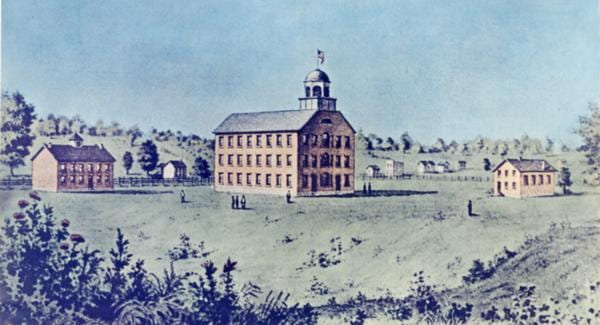BLOOMINGTON, Ind. – During the same year that Indiana University is marking its bicentennial, the IU Kelley School of Business is celebrating 100 years of preparing students to lead organizations, start companies, develop new products and services, and shape business knowledge and policy.
The IU Board of Trustees established a School of Commerce and Finance in 1920, but the story of business education at the university goes back to its origins 200 years ago. On January 20, 1820, the Indiana General Assembly established Indiana State Seminary in Bloomington, which became a college in 1828 and a university in 1838.
 In the Indiana Legislature’s act establishing Indiana State Seminary, the first section called for the education of youth in the “useful arts,” among other things. The focus, though, was classic liberal arts education. Within that initial curriculum — which included Latin, Greek, English, algebra, astronomy, mathematics, physical geography, philosophy and religion – was political economy, the forerunner of modern economics.
In the Indiana Legislature’s act establishing Indiana State Seminary, the first section called for the education of youth in the “useful arts,” among other things. The focus, though, was classic liberal arts education. Within that initial curriculum — which included Latin, Greek, English, algebra, astronomy, mathematics, physical geography, philosophy and religion – was political economy, the forerunner of modern economics.
Political economy was included in the university’s initial academic bulletin of 1830-31 as a senior-level course. Andrew Wylie, IU’s first president from 1829 to 1851, also held the academic title of professor of mental and moral philosophy, political economy and police literature. The university’s fifth and sixth presidents – Cyrus Nutt and Lemuel Moss – also held the same title and taught courses in the subject.
The term “economics” — either as a department name or in a faculty title — was not used until the mid-1880s, when Arthur B. Woodford held the faculty title of assistant and associate professor in economics and sociology. A Department of Economics and Social Science continued to grow in scope between 1887 and 1900.
It had become increasingly clear to IU presidents Joseph Swain (1893 to 1902) and William Lowe Bryan (1902–1937) that the university needed to expand and offer more professional areas of study. Up to that point, the only professional focus was the law.
Both the nation and the state were rapidly industrializing and the recently established Purdue University — with a more applied educational curriculum – was competing with IU for public and legislative support and to become the state’s “university.” As at other Midwest state universities, it was suggested that IU begin offering courses in commercial subjects.
“He thought this a good way to bring Indiana’s businessmen into closer touch with their university,” historian Thomas D. Clark wrote of Swain in his book, “Indiana University: Midwestern Pioneer.” “He believed this would do for Indiana University in the field of business what agriculture did for Purdue and the farmers. Already there was a stirring in the university and the state which really demanded that both break out of the shell of the past and the restrictive old-line liberal arts college.”
Foundations were prepared for professional programs, including the establishment of schools of medicine — which was dedicated after a protracted 11-year political battle, including with Purdue — education and business. Commerce courses were introduced to the economics curriculum in 1902.
Over the next several months, we hope you will regularly return to this blog to learn more about our moments that have led to momentum. You’ll find information about subscribing to your right, across this screen. We promise: it’s completely spam-free and you can opt out any time.
Next: The School of Commerce and Finance takes shape.

Proud of my IU MBA.